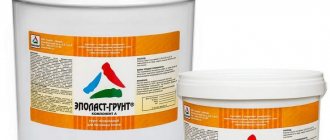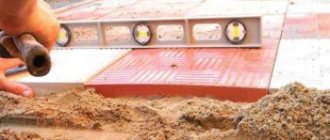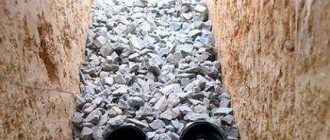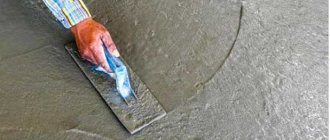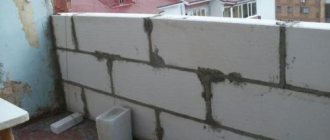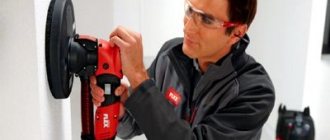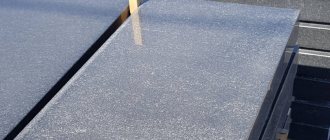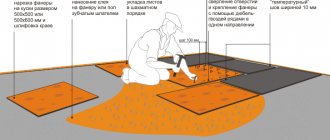Characteristics
There are different types of adhesive compositions:
- dry and liquid;
- for working with old concrete surfaces and lightweight concrete;
- for brick.
The composition is considered high quality if:
- It retains its properties for up to 4 hours.
- No film forms on the mixture within 20 minutes, on quick-drying for 10 minutes.
- The surface after the adhesive should not be slippery.
The characteristics indicated on the packaging are presented in the table:
| Symbol | Meaning |
| C1 | Ordinary |
| C2 | Improved |
| С2S | Withstands deformation |
| E | You can keep the package open |
| F | Hardens quickly |
| T | Doesn't slip |
| G | Liquid |
An adhesive that is made for tiles made from tile and ceramic materials
It is quite possible to prepare the tile mortar yourself. At the same time, it will be possible to glue the facing surface onto it without fear.
This mixture should include:
- packaging of a foam plastic block 20x20x20 mm;
- acetone.
In order to glue the tile, you need to turn it over with its back side. Consequently, foam is placed at the corners of the tiles and acetone is dripped onto each edge. Further, the tile composition tends to set on its own. This process occurs after a few seconds, due to the fact that the foam dissolves under the influence of the substances used. Thus, the resulting solution tightly adheres the tiles to the wall.
The technology for preparing a solution for gluing walls with ceramic tiles requires the same components as for tiles. But here it is necessary to prepare a special solution, which will have a ratio of 1:4 by volume. For more plastic properties of the solution, lime should be added to its composition. It should be no more than 1/5 of the total volume.
Note! It is strictly forbidden to add gypsum to the cement mortar, because the mixture will lose all its adhesive properties and the tile cladding will not adhere to the wall or floor.
Cement mortar, which is necessary for installing tile coverings on walls
Types of glue
Epoxy
This material is often used to fix tiles.
This is a waterproof mixture. It is a thin layer. The adhesive is necessary for screeding, waterproofing during the construction of walls, adhesion of surfaces made of roofing material and stone. The mixture is also used as an additional layer for old surfaces. Epoxy glue protects against mold. Suitable for tiles, concrete, chipboard, glue drywall to concrete wall, metal to concrete. This wood glue will also work. The base is epoxy resin. You can choose a shade that matches the concrete.
Furyl
The main one is furyl resin. It hardens at room temperature and above. Additional components are added in the form of quartz, graphite, and furyl adhesives of lower viscosity are created. They glue metals, plastics, ceramics, and glue roofing felt to concrete. Advantages: high strength, water resistance, chemical resistance, protects the surface from corrosion. The surfaces are dried, the glue is applied hot in two layers, and joined two hours after heating.
You can even glue roofing felt onto such a substance.
At the end of the work, you need to seal the room.
Supply of adhesive mixtures for repair and construction work
engages in the supply of adhesive compositions at wholesale prices with delivery to all regions of Russia. We sell adhesive mixtures for interior and exterior use, various loads, installation and operating conditions. Online store managers provide qualified advice on the selection of adhesive mixtures.
On a cement, gypsum or polymer base, assembly adhesives are a separate category. Both during construction and when finishing premises, it is impossible to get by only with screws, dowels and nails. Something needs to be fastened using a wet method. And although theoretically drywall can be glued to the wall and plaster, and the tiles can be laid on a simple cement mortar, in practice it is better to avoid this, since on the modern market there is no shortage of materials such as assembly adhesive.
For each operation there is its own type of assembly adhesive, depending on the purpose and the materials being glued. For the installation of various concrete blocks, including those made of porous concrete, cement-based adhesive is used. Cement adhesives are also used for laying ceramic and tiles, decorative stone, and natural stone cladding. When installing gypsum plasterboard, it is better not to use such glue, but drywall has no such contraindications, although it is still better to glue it using gypsum adhesives.
Universal cement-based adhesive is a rare phenomenon and not very necessary, since adhesives for tiles and blocks have significant differences. For example, if tile adhesive differs from ordinary cement-sand mortar mainly in the presence of special additives that increase adhesive ability (adhesion strength to the surface), then adhesive for porous concrete also differs in filler, which makes the mixture less dense, thereby avoiding cold bridges . Which, in turn, are inevitable when using regular mortar or tile adhesive.
Gypsum-based assembly adhesive is indispensable for frameless wall cladding with both (gypsum fiber sheets) and (plasterboard sheets). But blocks for the construction of partitions are not only concrete. In recent years, tongue-and-groove gypsum slabs have become increasingly popular, for the installation of which gypsum-based adhesive is used. This glue is made more liquid than “plasterboard”, and is applied in a much thinner layer.
Simply put, all products made from a similar material, including gypsum stucco, can be mounted using gypsum adhesives. However, these adhesives are suitable not only for gypsum products. The same thermal insulation (as an option - extruded polystyrene foam) is also glued to gypsum adhesives.
In addition to the construction adhesives described above, which are a dry mixture and are mixed with water immediately before work, there are ready-made adhesives made from various polymers. They go on sale in tubes and cartridges for applicators (in everyday life - pistols). One of the first brands to enter our market was the American Liquid Nails, which is why now citizens call any glue in a cartridge liquid nails, regardless of the manufacturer.
This glue is of little use for installing concrete or gypsum blocks (not counting the fact that a partition glued with liquid nails will become really “golden” in terms of cost), but for gluing and gluing all kinds of plastic, wood, metal and other products it is just right. Skirting boards, thresholds, moldings, baguettes, MDF and PVC panels and components, decorative and perforated corners, in some cases even glass, mirrors or drywall - the range of applications can be listed endlessly. The main thing is to carefully read on the packaging when purchasing what surfaces this or that type is intended for, since they are not nearly as universal as is commonly thought.
The most common in household use, and at the same time least used by professionals. I think there are few citizens who have never heard of glues such as Titan, PVA or some 88th glue. Despite its versatility, the same 88 is practically no longer used in finishing (although half a century ago plasterboard was often glued to it), PVA is used mainly for gluing wood, and Titanium, as a rule, finds application when facing ceilings with foam tiles or similar baguettes ( ceiling plinths). Although personally, even for such purposes, I prefer liquid nails, not synthetic ones, but water-dispersed ones. However, this does not mean at all that such glue is not needed at all - it glues surfaces quite well, and some even perfectly (of course, if you follow all the instructions), it just takes more time to use, and this is not always possible.
In general, this is quite enough for familiarization, and in the following notes we will try to consider all of the above in more detail, not only by type, but also by brand.
A good apartment renovation is everyone’s dream, but the task is for professionals.
From idea to implementation, a lot of time often passes, a lot of effort is put in and, of course, a lot of money is spent.
If at some stage - for example, on inviting a designer you can save money, then there are things that you should never save on.
And first of all, this concerns the choice of building materials, because high-quality repairs are also the result of the correctness and validity of the choice of materials through which the idea is implemented; even a very good idea can be ruined by a poor choice of materials. When it comes to tiling, the choice of adhesive is key.
When you go to a building materials store, you will be pleasantly surprised by the assortment of tile adhesives. On the one hand, this is good - you can choose a mixture that is suitable for the price and suits your needs, but on the other hand, do-it-yourself repairs also mean choosing the glue yourself... and with such a variety it is very easy to make a mistake.
However, as renovation experts say, when you don’t know what tile adhesive to buy, buy cement... Indeed, cement-based tile adhesive, or as professionals call it, cement colloidal mastic, is the most popular and universal type of adhesive mixtures.
It is practically free of disadvantages and is suitable for almost all types of work and any type of tile.
Manufacturers
| Characteristics | Stamps | |||
| "Osnovit Selform" | "Rusean" | "Volma Block" | "Itong" | |
| Package weight, kg | 20 | 25 | 25 | 25 |
| Air temperature during use | -10/+10 | +5/+30 | +5/+30 | +5/+30 |
| -10/+5 | ||||
| Consumption per 1m2, kg | 8 | 8 | 6 | 1,5—1,6 |
| Seam thickness, mm | 2—5 | 4—5 | 2—5 | 1—3 |
| Water consumption per 1 kg of mixture, l | 0,2—0,22 | 0,2 | 0,25 | 0,2 |
| Block adjustment time, min | 15 | 15 | 10 | 15 |
| Viability of solution, hour | 1 | 2 | 2,5 | 2—3 |
| Total concrete color | Grey | White | White | White gray |
Most often, builders resort to using Ceresit material.
“Ceresit” is considered the best adhesive composition for concrete; “Leader”, “Polyrem”, “Polimen” are also popular. These are representatives of domestic brands. As for foreign products, builders use French adhesives “Seder”, “Findley”, “Bostik”, as well as German “Jovi”, “Knauf”, “Emfi”. To create masonry from cellular concrete, they prefer to use the Monolith adhesive composition.
Application
- Clear the surface of debris.
- Clean the surface well. It is better to remove the top layer altogether, as it is fragile and peels off.
- Prepare the adhesive. If necessary, mix concrete adhesive with hardener. Calculate approximately how much is needed for work, since the time of use is limited.
- Glue. You can apply the glue with a spatula or brush, and immediately place the building material on top.
If the concrete is not 6 months old, then working with the adhesive is prohibited, as it may settle. Sometimes it is necessary to remove the top layer of concrete coating and then carry out gluing. Before the procedure, drywall and plastic must be washed with a mixture of soda and water. The construction market offers a wide range of adhesive products, but you must pay attention to the manufacturer and expiration date. The quality of the work performed depends on this.
How to glue at home
If there is a need to glue polyethylene at home, then you need to use IZ products. The gluing process depends on what base the film is attached to.
We suggest you familiarize yourself with How to water a tree so that it dries quickly: how to dry it out, destroy it
Between themselves
The polyethylene film will stick to each other BF-2. But before work you need to prepare:
- The surface is thoroughly cleaned of dirt, dust deposits, and degreased.
- Apply a layer of adhesive, distribute evenly, connect the surfaces.
- Press for a couple of hours until the mass sets.
This preparation is suitable for all types of connecting compounds.
Glue - toxic compounds, work is performed with gloves.
In addition to glue, double-sided tape, soldering the ends between two metal plates, or molten plastic will help to glue the film.
To metal
In order for the polyethylene to tightly and reliably cover the metal surface, you need to do the following:
- the metal plane is cleaned and degreased;
- warms up to 120–150 degrees;
- the film is carefully stretched, gradually applied to a metal plane, and rolled.
To concrete
It is not difficult to stick insulation to concrete, the main thing is to follow the rules:
- the concrete surface is cleaned, leveled, primed;
- glue is applied to the side of the insulation where there is no foil;
- wait a minute for the glue to soak in;
- apply cloth, press;
- the edges are additionally coated and fixed;
- wait until it dries completely.
How to glue polyethylene? There are a couple of possible answers:
- Iron welding. This is a fairly simple method, but it requires accuracy and subtlety of craftsmanship. To do this, the iron is heated to what temperature, it depends on the thickness of the material. The edges of the oilcloth are folded overlapping, then the edge or nose of the iron is drawn along the seam. Stay in place for no more than one second, as scorching will occur. Strength is checked by stretching two pieces of oilcloth.
- Open flame welding. For this method, you will need fire-resistant bars, between which the two edges of the film are fixed. An open flame from a match or gas burner melts the edges. This creates a dense bead that prevents the material from diverging.
